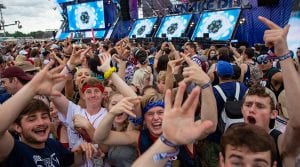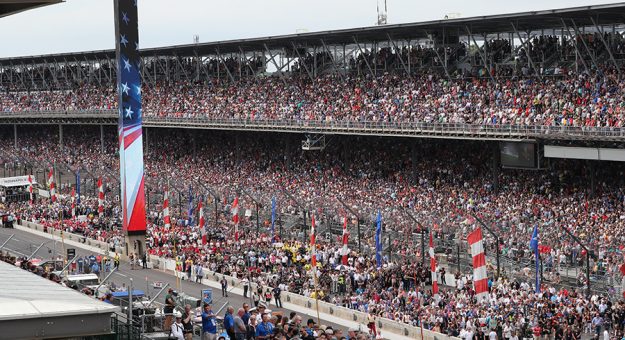Governor Holcomb said the data and metrics look positive.
“It’s like various events, whether it is March Madness or the Indianapolis 500, we look at what leads and drives the slope of the positivity rate that has to do with the hospitalizations, the deaths and the spread,” Holcomb said. “Has it plateaued or not and where is that slope? We are monitoring what’s happening on a daily basis. Then, we share that with community leaders and elected officials and boards of health, what is on the horizon.?
“It is one elaborate equation that will drive us on the results and the decision.”
Holcomb said it will be a special day when fans return to the Indianapolis 500.
“It will put a lot of joy into people’s hearts to know that we can do things and pull this off,” he said. “It’s part of our DNA to prove that it can be done in a safe way. It will mean a lot.”
While many Indy 500 ticket buyers waited for their much-anticipated “blue envelopes” to arrive containing their prized tickets to this year’s race, IMS official have taken a thorough and methodical approach to reaching a decision regarding how many may attend.
“The most important thing is to have the Indianapolis 500, the race itself, with as many people who want to be here,” Boles said. “I think we will still have people here for practice and qualifying and those pieces of the schedule as well, but our real focus is to get as many people here as possible that want to be here and do it in a responsible way. We will determine the ancillary events more after we determine how the Indy 500 looks.
“We want to have a normal May, but there are some challenges on having that in 2021. But the focus is on race day, May 30, and that is totally what we are focusing on now.”
Indianapolis Motor Speedway was the site of several mass vaccination efforts in March and April.
“Tens of thousands have been vaccinated at the Indianapolis Motor Speedway,” Holcomb said. “To see the teamwork that came together at IMS, with the Indiana State Department of Health, the Indiana National Guard and IU Health just getting at it. It was like watching one ginormous pit crew take care and save lives.
“People risk their lives out here at these races, but we are saving lives by the tens of thousands both in March and now in April.”

Boles and his team learned a tremendous amount from the data and metrics obtained during the NCAA Men’s Basketball Tournament, which was held entirely in the state of Indiana.
They focused on how the spectators were involved and the logistics of the venues, as well as observing the caterers and hospitality to understand what protocols need to be implemented.
“Our focus has been on that and what protocols the spectators went through, such as how were they enforcing spectators wearing masks, some of those things that would also apply to an outdoor venue,” Boles explained. “Any time you can watch an event right now as it is being executed, you are going to learn from it, whether it’s 100 people or 10,000 people. It was great for our city, for Indianapolis to show that we are thoughtful in the way we are hosting our events and want to host our events in a safe manner.
“The Indianapolis Motor Speedway wants to do the same thing as it relates to the Indianapolis 500.
“I went to the Daytona 500,” Boles continued. “Several of my staff actually worked the Super Bowl in various capacities so we got information from the Super Bowl and the Daytona 500. What happened in Indianapolis was not only helpful, but the legwork we did before March Madness helped us in Indianapolis.”
Even with the loss of revenue from not having the usual crowd of more than 250,000 fans at last year’s 500, it’s never been about the money to the new owner of Indianapolis Motor Speedway.
“The one great thing for the Indianapolis Motor Speedway over the last 16 months is Roger Penske has never once worried about the revenue,” Boles noted. “His focus has always been on the customer experience and what can we do to make sure this is as easy on the customers as possible. We know how passionate they are for the 500. Let’s get through 2020, have a 2021 and then we will start thinking about what that revenue piece looks like in 2022.
“I was in a meeting with Roger and some other folks and he said, ‘I didn’t make this investment for a short-term gain. This is a long-term opportunity for us. I want to grow the Indianapolis Motor Speedway. It’s not about what happens in the first year.’
“I think we are all blessed that Roger Penske is at the helm because it’s not about the money; it’s about keeping the sport and the Indianapolis Motor Speedway healthy.”
It’s the focus of Penske, Boles and their team that will lead the Indy 500 out of the darkness of the pandemic.
“There are days in the middle of a pandemic where you wake up and don’t know where to begin or what to do and it’s really easy to be done,” Boles said. “I have not seen Roger Penske once feel defeated or down. He is always optimistic. He looks at it as an opportunity and we are going to get through this. His leadership has been amazing.
“If I were coveting something, I would covet his attitude and spirit. You see why he is so successful because his attitude doesn’t allow him to think of failure; he knows he is going to succeed. I believe we are going do the same.”
